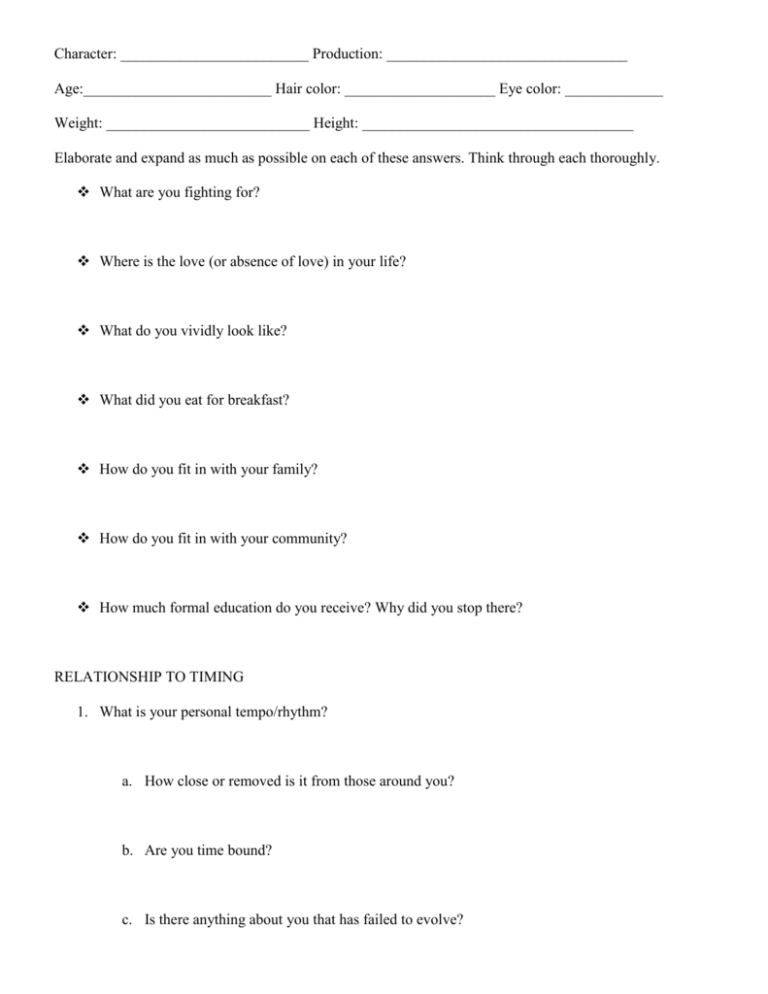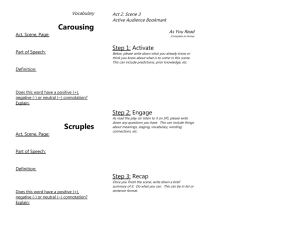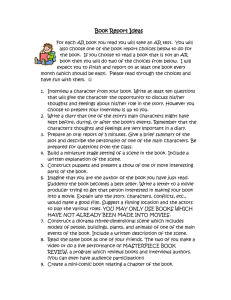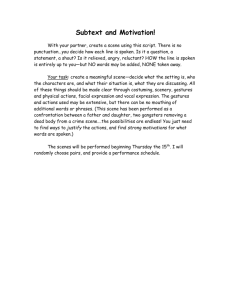TIME
advertisement

Character: _________________________ Production: ________________________________ Age:_________________________ Hair color: ____________________ Eye color: _____________ Weight: ___________________________ Height: ____________________________________ Elaborate and expand as much as possible on each of these answers. Think through each thoroughly. What are you fighting for? Where is the love (or absence of love) in your life? What do you vividly look like? What did you eat for breakfast? How do you fit in with your family? How do you fit in with your community? How much formal education do you receive? Why did you stop there? RELATIONSHIP TO TIMING 1. What is your personal tempo/rhythm? a. How close or removed is it from those around you? b. Are you time bound? c. Is there anything about you that has failed to evolve? RELATIONSHIP TO PHYSICAL SPACE 2. What is the size, flexibility and scope of your personal bubble? a. How easily does it adjust? 3. How do you connect with and use the space, surfaces, and shapes around you? 4. Do some rooms get too small for you as you suddenly as you suddenly realize that you are overloud and overbold? a. Does the reverse happen? b. How sensitive are you to the space needs of others? PLACE 5. Do your attitudes, behaviors, and vocal and physical lives reflect where you came from, no matter where you are? a. Are you place bound? b. To what extent do you recognize and adapt to the place you are in? 6. What sort of places do people associate with you, even if they are not part of your actual experience? 7. Where do you feel most at home? a. Most stimulated? b. Where do you feel you really belong? RELATIONSHIP TO VALUES 8. Do you have beliefs that are widely shared? a. Do some beliefs make you feel almost as though you were from another planet? 9. Which assumptions about right most strongly influence your interactions? 10. How clearly do you communicate your values through presentation of self? a. How often are you misinterpreted? b. Do you bite your tongue and keep your own counsel, or do you impose your thoughts regularly? RELATIONSHIP TO STRUCTURE 11. What is your relationship to authority? a. How likely are you to accept, defy or manipulate the power of others? b. Where do you present yourself between rebel and conformist? 12. How easily do you move between social, economic, political, spiritual and cultural groups? a. How aware and flexible is your sense of appropriate behavior? 13. How do you impose structure on the lives of others? RELATIONSHIP TO BEAUTY 14. Where do you place yourself on the beauty scale, and how have you responded to that? a. Are your own tastes or preferences outside the norm? b. Do you reveal this? c. Under what circumstances? 15. How do you change your looks when you appear before others? a. Where do you work hardest to adjust/improve yourself? 16. What are your favored modes of artistic impression? RELATIONSHIP TO ATTRACTION 17. Are you aware of what is sexually attractive about you? a. Of what is not? b. Do you exploit this in any way? 18. How do you emphasize, reveal, or hide parts of your body? a. Which ones? 19. How do you express your sexuality? a. Are you embarrassed, tolerant, or defiant of “normal” courtship behavior? RELATIONSHIP TO RECREATION 20. Do you find certain things fun that others find boring or difficult? 21. Which of your pleasures are shared or unique? a. Are there “pastimes” you find impossible to comprehend? b. Are there some to which you are addicted? 22. What are you on doer/watcher scale? a. Thinker/feeler? b. Celebrant/Mediator? RELATIONSHIP TO SIGHT AND SOUND 23. What are some vocal mannerisms (stutter, breathing, etc.)? a. How do they affect how you speak? b. How you laugh? c. Your vocal rhythms? 24. What physical attributes enhance or disrupt speech pattern? a. How do they affect how you speak? b. How you laugh? c. Your vocal rhythms? 25. How do your physical habits/vices affect these same factors? 26. Does your speech or movement fit better in some situations or others? TONAL PATTERNS OF VOICE 27. Quality 28. Force 29. Tempo 30. Pitch MUSIC AND DANCE 31. What is your theme song? a. Which is your dance? 32. Which style of music reflects you best? 33. To what extent do you use music and dance to express yourself? 34. How do you express these things- in your walk, talk, glances, facial expressions? MASKING 35. Which are the faces you wear in public? 36. When does the façade drop most readily, and when can it be counted on to appear? 37. Which of your masks works well for you? a. Which gets in the way? 38. Is there a progress toward a more moral being? a. Have recognizable qualities of a spiritual nature manifested themselves by the end of the play? 39. Is maturity of mind or body the goal the author has set for the character? 40. Or is a degeneracy of will or desire apparent? 41. Is the growth of a reverse kind, leading to a less moral being or less pleasing personality? 42. What is the result of the growth or deterioration? 43. Does it produce materialistic gain or loss? a. Is personal happiness achieved? 44. When and how does the change manifest itself? 45. Does the change affect in any way the basic desire of the character? a. If so, how? b. Why? THE WHOLE CHARACTER 46. Make a list of single or modified words to describe the character based on above findings. 47. Select one to four of the most important words from the above list that will project your intent to the audience. 48. What do you love? 49. What do you despise? 50. What are your priorities in life? 51. What makes you smile? 52. What makes you cry? 53. What do you fear (in general)? a. Where does it stem from? b. How does it affect you? c. How is it magnified? d. How it relieved? e. How does it affect your choices? f. How does it affect your reactions? 54. Do you let fear control you? 55. How do you fight fear? 56. What do you fear in this show? RELATIONSHIP TO POSITION AND MOVEMENT 57. In both position and movement is the weight generally forward on the balls of the feet, or is it over the middle or on the heels? 58. Is the base broad or narrow, or are both positions used as circumstances alter? 59. How do the heels strike the ground when walking? 60. Is there a bounce or drag in the step? 61. Is the character either splayfooted or pigeon-toed? 62. When seated, how does the character cross the legs- at the ankles or knees, and how broad is the base? 63. Does the abdomen protrude- if so, is it because of weight or personality- or is it pulled in, or in the required position of naturally good position? 64. Within the limitations of the character’s physical makeup, is there good posture? a. If not, are the shoulders habitually hunched forward or stiffly held back? 65. Are the elbows aggressively thrust out or timidly tucked in? a. Might there be a middle or normal position between the two extremes? b. Is it likely that the character would employ more than one elbow position or movements? 66. Is the hand often used as a whole unit, as when it is formed into a fist placed on the hips, or is there flexible action between fingers and thumb? 67. Does the head thrust toward objects and persons or withdraw from them? a. Does it ever turn away form objects in distrust, or tilt from one side to another is a display of interest? b. Does it droop from muscular slackness or is it held erect? 68. Is the chin aggressively extended or shyly pulled in? 69. Which is habitual, an emphasis upon the horizontal or the vertical lines of the forehead (how do you frown)? a. Is marked flexibility (doing both for different occasions) in this respect proper? 70. Do the eyes squint? a. If so, is it because of poor eyesight or because of a habitual attitude of distrust? b. Or are the lids opened wide in amazement or innocence? c. Would your character run the range of all the above actions? 71. Is the mouth held slackly open or does an attitude of determination cause tenseness in the jaw and lip muscles? 72. Are the corners of mouth more often pulled up in good humor than pulled down in bad? 73. Discuss physical ailments or disabilities, previous or new, which affect how you walk? a. How you stand? b. How you sit? c. How you turn? RELATIONSHIP TO CLOTHING 74. How does the character wear his costume, and what use can you make of his manner? Consult word list. 75. In addition to the basic purpose of wearing clothes, does the character use them for any other purpose? 76. What does the character think of his clothes? DISTINCTIVE CHARACTER MOVEMENT 77. Develop one to four distinctive character movements, revealing any one of the character’s most important personality traits, and weave them into movement or position or tonal patterns as they extend throughout the play. THIS WORK REQUIRES YOU TO USE SEPARATE SHEETS OF PAPER. RELATIONSHIPS For each relationship in this production, create a profile on a separate sheet of paper. Answer the following questions in detail. Describe each relationship in one all-encompassing word (ex. June = ____________) Give a brief history of your relationship with each person. Select a sound or gesture to represent your feelings for this person. When you see each person, what is your initial reaction to him or her? How do you express love with this person? o Anger? Do you attempt to mask that? Why and how? o Disappointment? How does your initial reaction to each person change as the action progresses? Does this change bases on the company present? How does this relationship evolve as action progresses? SITUATIONAL For each scene in which you are involved, complete the following on a separate sheet of paper: SCENE:________________________________________________ What is your intention for entering the scene? What is your initial mood? o Why? What are the stakes? How does that mood change/progress over the course of the scene? o Why? What is your initial feeling for each person sharing the scene with you? What do you want? Did you get it? How has your character grown/evolved/progressed as of the result of the action in this scene? What is your intention as you exit the scene or the scene ends?









